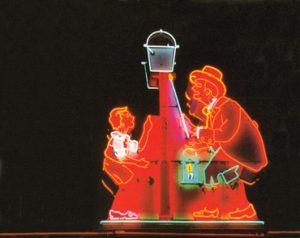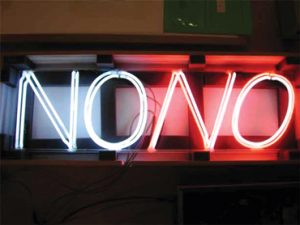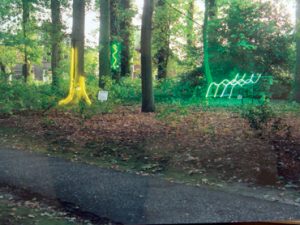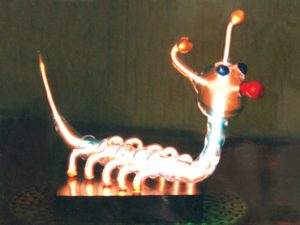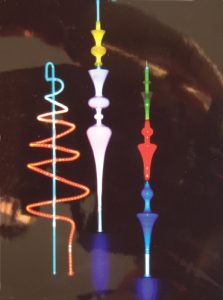Assuming few readers like to delve into deep math as a pastime, this month I‘ll discuss the vague, if nonexistent, distinction between neon signage and artwork.
Neon art poses challenges, but also bring rewards. If you want to produce neon art, don’t expect normal, sign-production work. And prepare yourself for other surprises.
A neon-art repair project certainly provided a “now for something completely different” moment for me. I’d received photos of a small, approximately 3-ft.-wide, window-sign type object (below). I never expected it would arrive in a car-sized, triple, box-in-box container delivered via an air-conditioned, 38-ton flatbed truck. It was handled only with white gloves. I cleaned out my garage to unpack it.
Is it a sign or art?
Advertisement
Neon-sign fabrication has always been an art form since neon’s invention in 1910. But, since the 1960s, artists have discovered neon’s artistic possibilities. First, cartoon-like caricatures showed up as signs. Using posterization, the Pop-Art movement focused attention on advertising and signage as artistic expression.
Correct tubing-fabrication methods require practice and equipment, so only a few artists who use neon fabricate it themselves. Most artists relegate fabrication to a well-known local neon shop.
Artists want to be treated like artists, and they normally ask the neonbender to create something technically impossible, as if it’s a production piece. Because of an artist’s demands, art projects clog up the production-shop workflow. Thus, the neonbender/installer must gently ground the levitated artist back to electrical safety.
Grounding the artist
The National Electrical Code, paragraph 600, and the Underwriter Laboratory’s standard UL 48 describe sign and outline lighting’s usage, but don’t define precisely what a sign is. Artists may find some loopholes to circumvent the U.S. regulations, but not in Europe, where regulations only reference the voltage implied, not the usage (sign or art).
Advertisement
Often artists claim art must not be restricted by regulations, which I can agree with, if no safety regulations are involved. I have witnessed “art” pieces that expose lethal voltage – viewers are protected only by keeping away from it.
Because art is presented publicly, and normally within arm’s reach, it must be absolutely safe, not to say fool- and childproof (normally, gallery operators don’t know much about electricity).
Also, artists would like to hide all electrical components, but tube suspensions and cabling can’t be totally invisible.
Neon signs’ longevity sometimes outsurvives businesses, but neon art pieces are often run 24/7 for decades. Thus, tube quality becomes a major issue. Always use top-quality components, because you won’t save money using low-quality materials. (However, I make money fixing them.)
Artists complain about even the slightest color deviation. Thus, I always make samples from the glass batch from which I’ll execute the actual work and obtain the artist’s approval (if possible, in writing) before starting.
I make three or four versions of an art piece. First, I work with plain, clear glass to familiarize myself with the steps and pattern to ensure smooth bending; if needed, I’ll correct the sequence and/or splice locations. Next, I make a unit, take a break, make two more, then select the best one. This minimizes, or eliminates, uneven bends and “sloppy,” unsmooth glasswork, which artists rarely desire.
Advertisement
Repairwork must perfectly match the original color and bending style, so the repair must be absolutely invisible.
Difficulties arise when trying to match or replicate original glass or colors that have been discontinued for years. I usually dig through many neon-shop basements to find the original glass. I also keep a good stock of classic, colored-glass tubing. Uranium and the “old” Corning ruby-red glass are sometimes traded in quarter sticks as if they’re sacred.
Some colors, such as the old “hot pink” (blue pumped red) can’t be matched, because the color depends on so many parameters that vary over time. In such cases, contact the original artist (if he or she is still alive) to find out the original intention and if she (or he) will accept a remake, in the same color, with new tubing. Prepare color samples to show/photograph alongside the existing object to obtain clearance.
Electronic or magnetic?
Neon artwork often is designed for indoor use, which doesn’t allow as noisy a distraction as the hum of a magnetic transformer. Therefore, electronic power supplies are the primary choice indoors, as long as they can be located near the tubing, and the high-voltage wiring doesn’t run through, or contact, metal bodies.
For outdoor installations, humidity, not noise, is an issue, and magnetic transformers are normally preferred. Today, many large, neon-art installations commonly use dimming and computer control.
They use either DMX-controllable, electronic power supplies or stage-type dimmer racks, which can take magnetic neon transformers’ low power factor, inductive load.
Neon art isn’t restricted to tubular lamps. Neon art often incorporates “plasma,” which is somewhat of a misnomer. Any gas lit by an electrical discharge will become a plasma, but artists often refer to situations in which single-electrode (or no-electrode), gas-filled vessels are lit up via radio-frequency power as “plasma.” Single- or no-electrode tubes can’t be processed in the same way as “standard” neon tubes. Instead, they are usually processed in an oven.
Bombarding tubes with non-uniform diameters is tricky, because thin, small-diameter sections melt before large-diameter sections are thoroughly heated. It may help to process tubing and electrodes in two steps.
First, convert the electrode activation at low pressure, when the glass won‘t be sufficiently heated, and then, after evacuating, refill with helium at approximately 10 to 20mbar to re-bombard the glass at a higher current without overheating the electrodes. (Hint: This trick also applies to processing long, 15mm-diameter border tubes when the client specifies 15/30, short-shell electrodes!)
Thus, fabricating neon for artists and art installations requires a completely non-commercial approach that incorporates the highest-quality materials and most accurate standards to make the impossible possible.
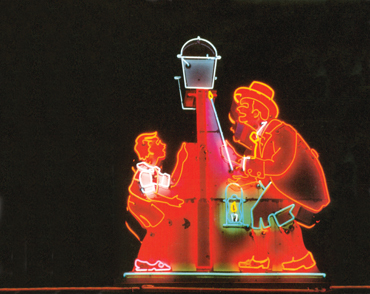


 Tip Sheet1 week ago
Tip Sheet1 week ago
 Photo Gallery3 days ago
Photo Gallery3 days ago
 Ask Signs of the Times5 days ago
Ask Signs of the Times5 days ago
 Real Deal2 weeks ago
Real Deal2 weeks ago
 Benchmarks1 week ago
Benchmarks1 week ago
 Photo Gallery8 hours ago
Photo Gallery8 hours ago
 Women in Signs2 weeks ago
Women in Signs2 weeks ago
 Women in Signs1 week ago
Women in Signs1 week ago